Carbocyanine-Based Optical Sensor Array for the Discrimination of Proteins and Rennet Samples Using Hypochlorite Oxidation
Abstract
1. Introduction
2. Materials and Methods
2.1. Reagents
2.2. Instrumentation
2.3. General Procedures
2.4. Determination of Protein in Rennet Samples
2.5. Data Processing
3. Results and Discussion
3.1. Development of the Test
3.1.1. Hypochlorite–Protein–Dye Interactions
3.1.2. Mixing order in NaOCl–Protein–Dye System
3.1.3. Effect of pH on the Signal
3.1.4. Effect of Hypochlorite/Protein Ratio
3.2. Discrimination of Model Proteins
3.3. Detection of Various Protein Concentrations
3.4. Discrimination of Rennet Samples
4. Conclusions
Supplementary Materials
Author Contributions
Funding
Institutional Review Board Statement
Informed Consent Statement
Data Availability Statement
Acknowledgments
Conflicts of Interest
References
- Li, Z.; Suslick, K.S. The optoelectronic nose. Acc. Chem. Res. 2020, 54, 950–960. [Google Scholar] [CrossRef] [PubMed]
- Sun, J.; Lu, Y.; He, L.; Pang, J.; Yang, F.; Liu, Y. Colorimetric sensor array based on gold nanoparticles: Design principles and recent advances. Trends Anal. Chem. 2020, 122, 115754. [Google Scholar] [CrossRef]
- Li, Y.-Q.; Feng, L. Progress in Paper-based Colorimetric Sensor Array. Chin. J. Anal. Chem. 2020, 48, 1448–1457. [Google Scholar] [CrossRef]
- Miranda, O.R.; Chen, H.-T.; You, C.-C.; Mortenson, D.E.; Yang, X.-C.; Bunz, U.H.F.; Rotello, V.M. Enzyme-Amplified Array Sensing of Proteins in Solution and in Biofluids. J. Am. Chem. Soc. 2010, 132, 5285–5289. [Google Scholar] [CrossRef] [PubMed]
- Lu, Y.; Liu, Y.; Zhang, S.; Wang, S.; Zhang, S.; Zhang, X. Aptamer-based plasmonic sensor array for discrimination of proteins and cells with the naked eye. Anal. Chem. 2013, 85, 6571–6574. [Google Scholar] [CrossRef] [PubMed]
- Wei, X.; Wang, Y.; Zhao, Y.; Chen, Z. Colorimetric sensor array for protein discrimination based on different DNA chain length-dependent gold nanoparticles aggregation. Biosens. Bioelectron. 2017, 97, 332–337. [Google Scholar] [CrossRef]
- Lu, Z.; Lu, N.; Xiao, Y.; Zhang, Y.; Tang, Z.; Zhang, M. Metal-Nanoparticle-Supported Nanozyme-Based Colorimetric Sensor Array for Precise Identification of Proteins and Oral Bacteria. ACS Appl. Mater. Interfaces 2022, 14, 11156–11166. [Google Scholar] [CrossRef]
- Rogowski, J.L.; Verma, M.S.; Gu, F.X. Discrimination of Proteins Using an Array of Surfactant-Stabilized Gold Nanoparticles. Langmuir 2016, 32, 7621–7629. [Google Scholar] [CrossRef]
- Rogowski, J.L.; Verma, M.S.; Chen, P.Z.; Gu, F.X. A “chemical nose” biosensor for detecting proteins in complex mixtures. Analyst 2016, 141, 5627–5636. [Google Scholar] [CrossRef]
- Sun, Z.; Wu, S.; Ma, J.; Shi, H.; Wang, L.; Sheng, A.; Yin, T.; Sun, L.; Li, G. Colorimetric Sensor Array for Human Semen Identification Designed by Coupling Zirconium Metal–Organic Frameworks with DNA-Modified Gold Nanoparticles. ACS Appl. Mater. Interfaces 2019, 11, 36316–36323. [Google Scholar] [CrossRef]
- Behera, P.; De, M. Nano-Graphene Oxide Based Multichannel Sensor Arrays towards Sensing of Protein Mixtures. Chem. Asian J. 2019, 14, 553–560. [Google Scholar] [CrossRef] [PubMed]
- Peveler, W.J.; Landis, R.F.; Yazdani, M.; Day, J.W.; Modi, R.; Carmalt, C.J.; Rosenberg, W.M.; Rotello, V.M. A Rapid and Robust Diagnostic for Liver Fibrosis Using a Multichannel Polymer Sensor Array. Adv. Mater. 2018, 30, 1800634. [Google Scholar] [CrossRef] [PubMed]
- Li, Q.-Y.; Ma, L.; Li, L.; Wang, S.; Li, X.; Zhang, C.; Zhang, Y.; Jiang, M.; Wang, H.; Huang, K.; et al. Array-based sensing of amyloidogenic proteins and discrimination of cancer by using different oxidants doped carbon nanodots as fluorescent probes. Chem. Eng. J. 2022, 430, 132696. [Google Scholar] [CrossRef]
- Fan, J.; Qi, L.; Han, H.; Ding, L. Array-Based Discriminative Optical Biosensors for Identifying Multiple Proteins in Aqueous Solution and Biofluids. Front. Chem. 2020, 8, 572234. [Google Scholar] [CrossRef] [PubMed]
- Fahimi-Kashani, N.; Ghasemi, F.; Bigdeli, A.; Abbasi-Moayed, S.; Hormozi-Nezhad, M.R. Chapter 17—Nanostructure-based optical sensor arrays: Principles and applications. In Sensing and Biosensing with Optically Active Nanomaterials; A Volume in Micro and Nano Technologies; Sahoo, S.K., Ed.; Elsevier: Amsterdam, The Netherlands, 2022; pp. 523–565. [Google Scholar] [CrossRef]
- Wang, L.; Hu, Z.; Wu, S.; Pan, J.; Xu, X.; Niu, X. A peroxidase-mimicking Zr-based MOF colorimetric sensing array to quantify and discriminate phosphorylated proteins. Anal. Chim. Acta 2020, 1121, 26–34. [Google Scholar] [CrossRef]
- Wang, F.; Na, N.; Ouyang, J. Particle-in-a-frame gold nanomaterials with an interior nanogap-based sensor array for versatile analyte detection. Chem. Commun. 2021, 57, 4520–4523. [Google Scholar] [CrossRef]
- Stepanova, I.A.; Lebedeva, A.N.; Shik, A.V.; Skorobogatov, E.V.; Beklemishev, M.K. Recognition and Determination of Sulfonamides by Near-IR Fluorimetry Using Their Effect on the Rate of the Catalytic Oxidation of a Carbocyanine Dye by Hydrogen Peroxide. J. Anal. Chem. 2021, 76, 1397–1405. [Google Scholar] [CrossRef]
- Shik, A.V.; Stepanova, I.A.; Doroshenko, I.A.; Podrugina, T.A.; Beklemishev, M.K. Carbocyanine-Based Fluorescent and Colorimetric Sensor Array for the Discrimination of Medicinal Compounds. Chemosensors 2022, 10, 88. [Google Scholar] [CrossRef]
- Shik, A.V.; Skorobogatov, E.V.; Bliznyuk, U.A.; Chernyaev, A.P.; Avdyukhina, V.M.; Borschegovskaya, P.Y.; Zolotov, S.A.; Baytler, M.O.; Doroshenko, I.A.; Podrugina, T.A.; et al. Estimation of doses absorbed by potato tubers under electron beam or X-ray irradiation using an optical fingerprinting strategy. Food Chem. 2023, 414, 135668. [Google Scholar] [CrossRef]
- Hawkins, C.L.; Davies, M.J. Hypochlorite-induced oxidation of proteins in plasma: Formation of chloramines and nitrogen-centred radicals and their role in protein fragmentation. Biochem. J. 1999, 340, 539–548. [Google Scholar] [CrossRef]
- Hawkins, C.L.; Pattison, D.I.; Davies, M.J. Hypochlorite-induced oxidation of amino acids, peptides and proteins. Amino Acids 2003, 25, 259–274. [Google Scholar] [CrossRef] [PubMed]
- Lin, H.; Jang, M.; Suslick, K.S. Preoxidation for Colorimetric Sensor Array Detection of VOCs. J. Am. Chem. Soc. 2011, 133, 16786–16789. [Google Scholar] [CrossRef] [PubMed]
- Bezie, A.; Regasa, H. The Role of Starter Culture and Enzymes/Rennet for Fermented Dairy Products Manufacture—A Review. Nutr. Food Sci. Int. J. 2019, 9, 21–27. [Google Scholar] [CrossRef]
- Okoh, O.A.; Bisby, R.H.; Lawrence, C.L.; Rolph, C.E.; Smith, R.B. Promising near-infrared non-targeted probes: Benzothiazole heptamethine cyanine dyes. J. Sulfur Chem. 2014, 35, 42–56. [Google Scholar] [CrossRef]
- Zakharenkova, S.A.; Katkova, E.A.; Doroshenko, I.A.; Kriveleva, A.S.; Lebedeva, A.N.; Vidinchuk, T.A.; Shik, A.V.; Abramchuk, S.S.; Podrugina, T.A.; Beklemishev, M.K. Aggregation-based fluorescence amplification strategy: “Turn-on” sensing of aminoglycosides using near-IR carbocyanine dyes and pre-micellar surfactants. Spectrochim. Acta A 2021, 247, 119109. [Google Scholar] [CrossRef] [PubMed]
- Bradford, M.M. A rapid and sensitive method for the quantitation of microgram quantities of protein utilizing the principle of protein-dye binding. Anal. Biochem. 1976, 72, 248–254. [Google Scholar] [CrossRef]
- Abdelmoez, W.; Yoshida, H. Production of Amino and Organic Acids from Protein Using Sub-Critical Water Technology. Int. J. Chem. React. Engin. 2013, 11, 369–384. [Google Scholar] [CrossRef]
- Spahr, I.F.; Edsall, J.T. Amino acid composition of human and bovine serum mercaptalbumins. J. Biol. Chem. 1964, 239, 850–854. [Google Scholar] [CrossRef]
- Paice, M.G.; Jurasek, L. Structural and Mechanistic Comparisons of Some β-(1→4) Glycoside Hydrolases. Hydrolysis of Cellulose: Mechanisms of Enzymatic and Acid Catalysis. Adv. Chem. 1979, 181, 361–374. [Google Scholar] [CrossRef]
- Crumpton, M.J.; Wilkinson, J.M. Amino acid compositions of human and rabbit gamma-globulins and of the fragments produced by reduction. Biochem. J. 1963, 88, 228–234. [Google Scholar] [CrossRef]
- Mills, J.; Tang, J. Molecular weight and amino acid composition of human gastricsin and pepsin. J. Biol. Chem. 1967, 242, 3093–3097. [Google Scholar] [CrossRef] [PubMed]
- Dattagupta, J.K.; Fujiwara, T.; Grishin, E.V.; Lindner, K.; Manor, P.C.; Pieniazek, N.J.; Saenger, W.; Suck, D. Crystallization of the fungal enzyme proteinase K and amino acid composition. J. Mol. Biol. 1975, 97, 267–271. [Google Scholar] [CrossRef] [PubMed]
- Yu, J.; Iwasaki, S.; Tamura, G.; Arima, K. Physical Properties and Amino Acid Composition of Mucor-rennin Crystal Isolated from Mucor pusillus var. Lindt. Agric. Biol. Chem. 1968, 32, 1051–1052. [Google Scholar] [CrossRef]



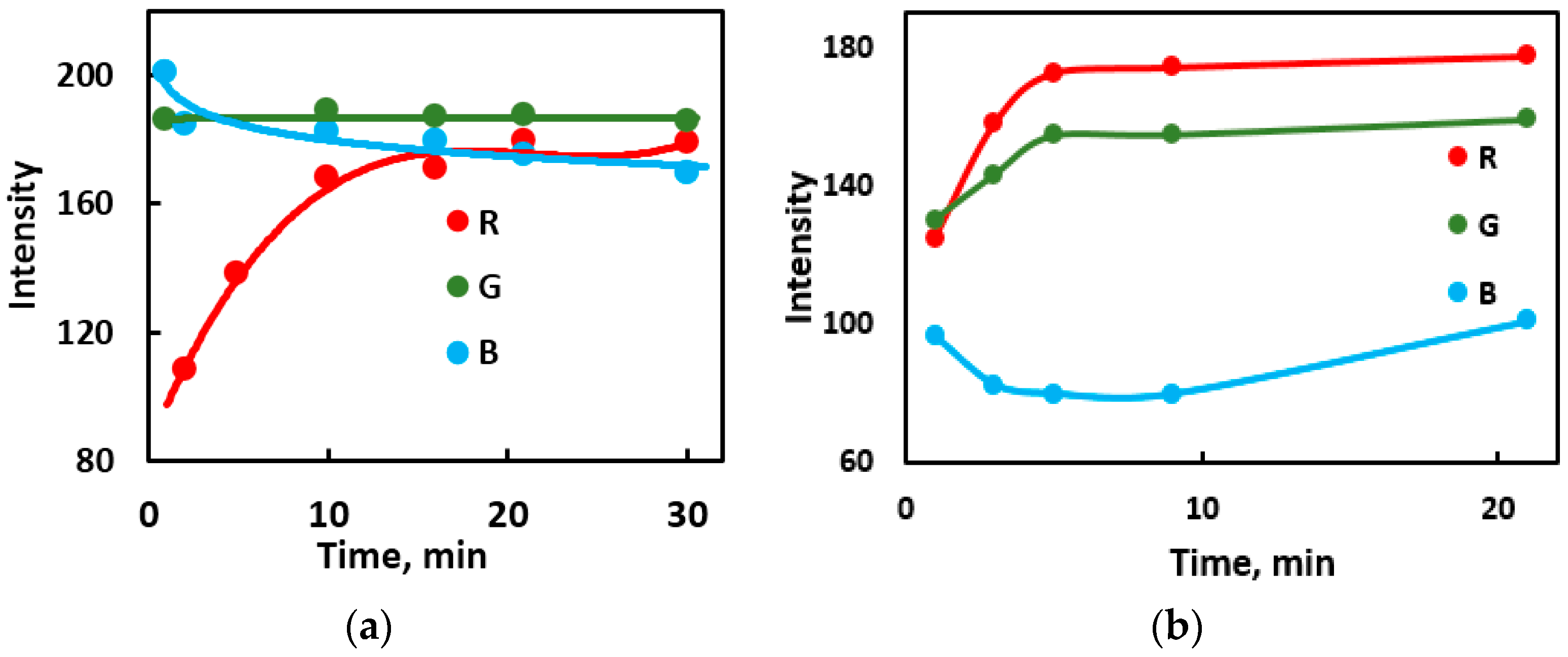
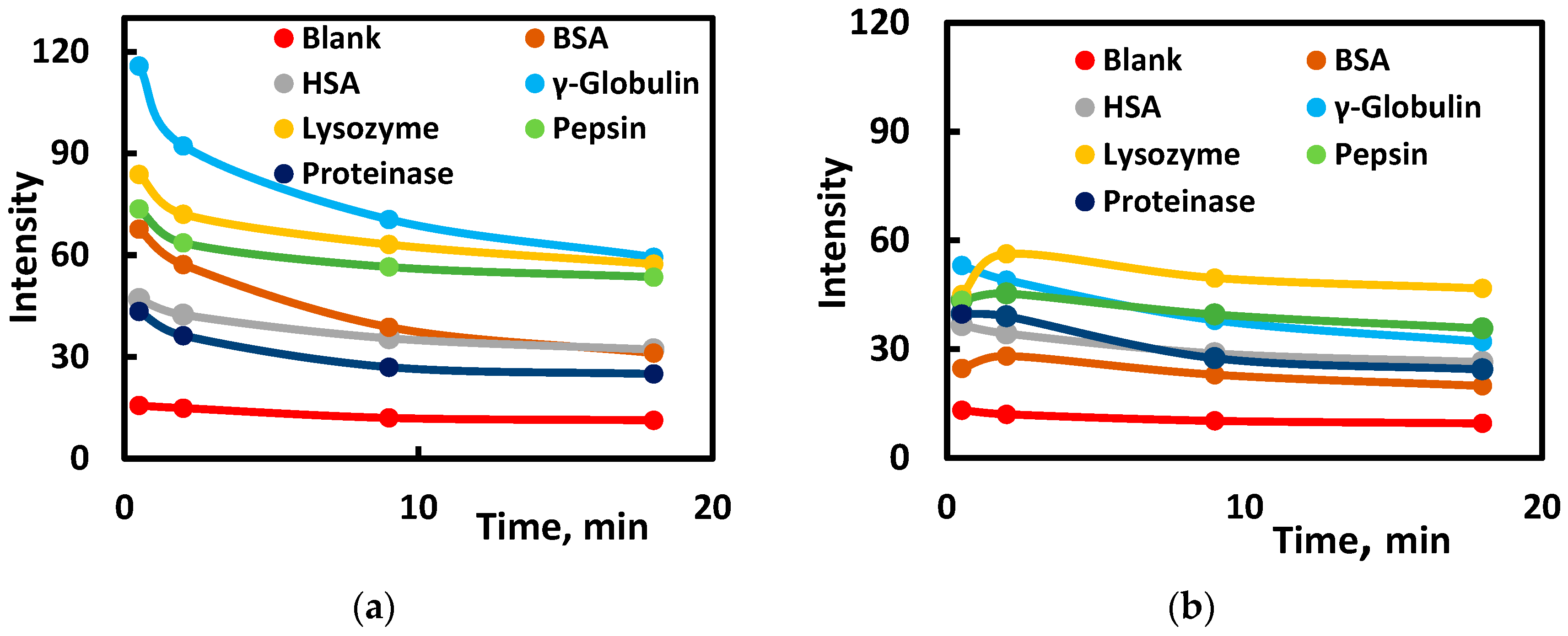
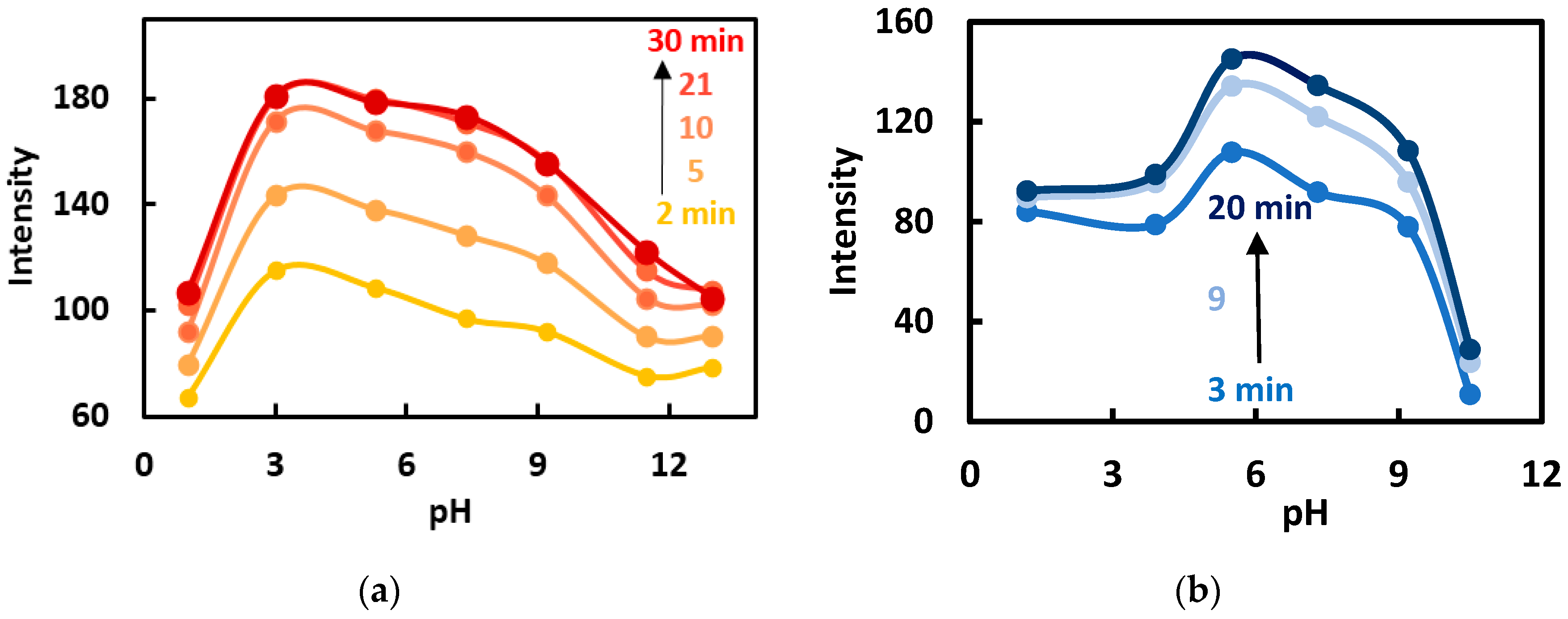
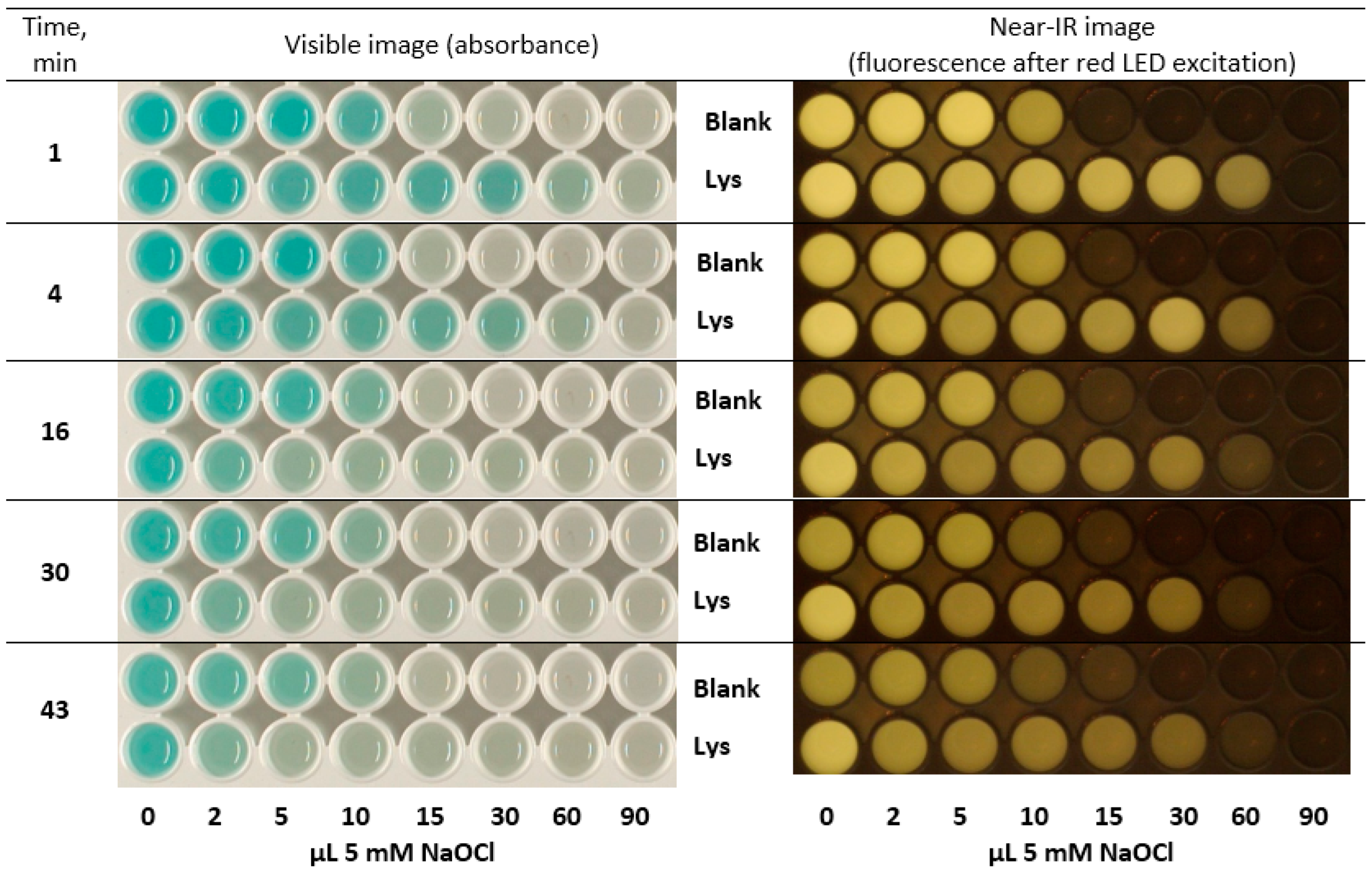
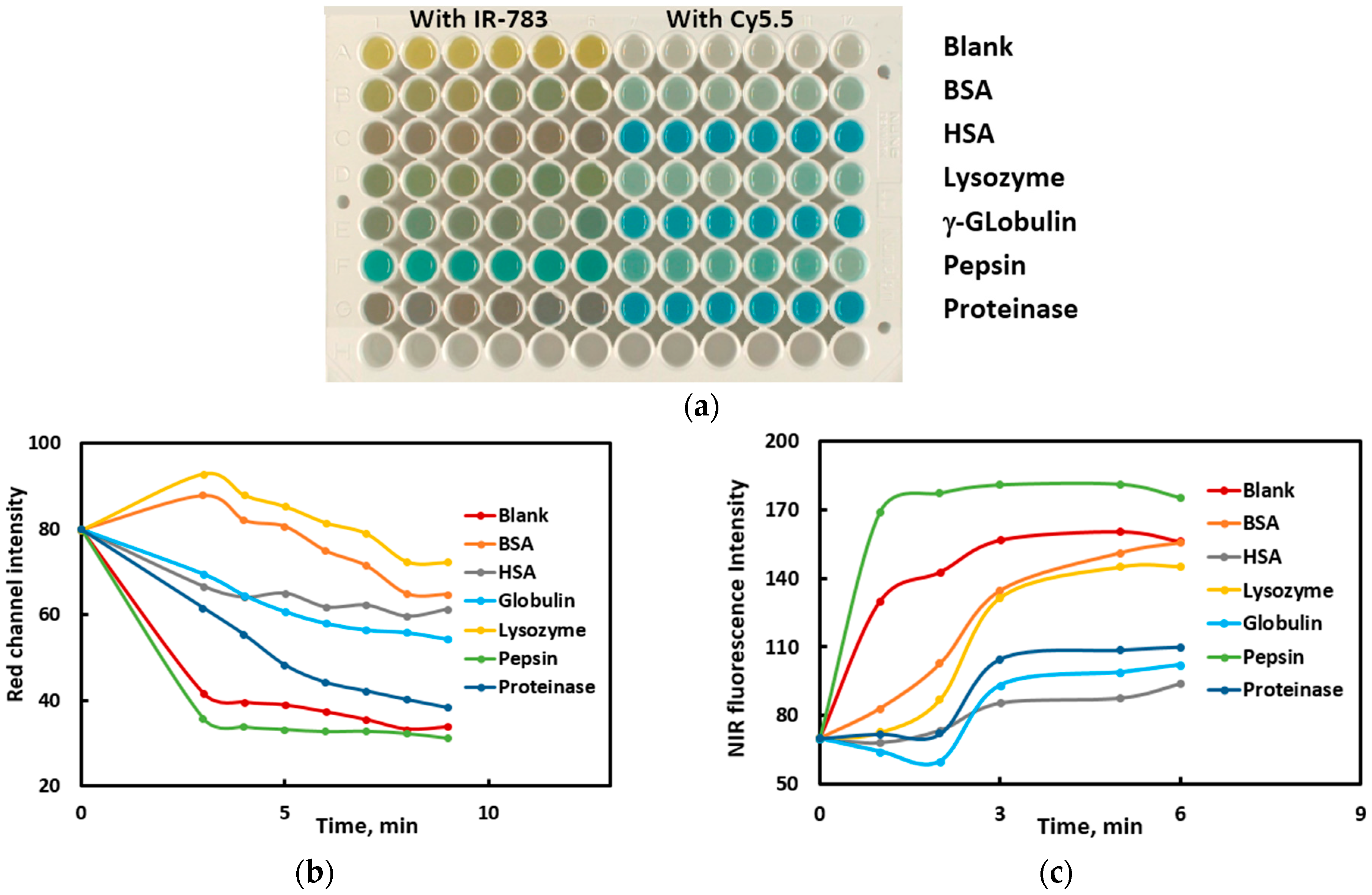

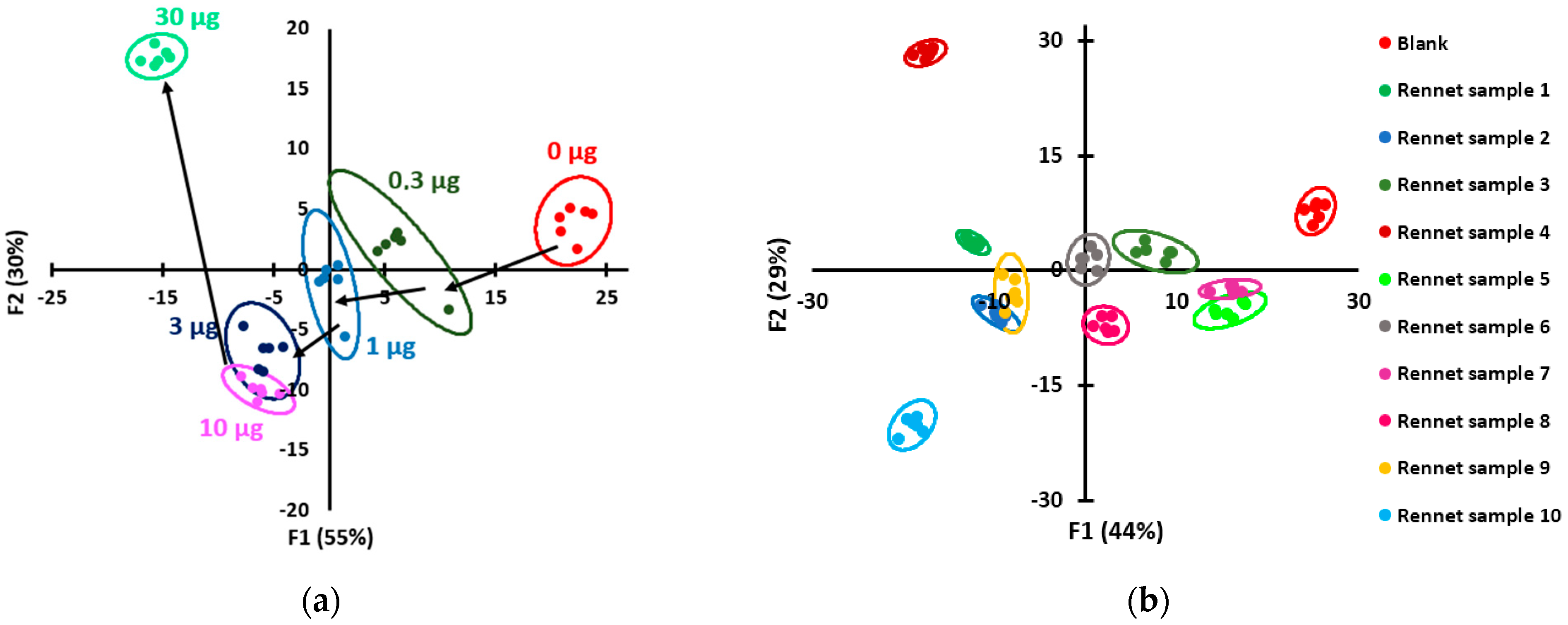
| No | Composition | Total Protein Content, % |
|---|---|---|
| 1 | Chymosin from Kluyveromyces lactis yeast (Spain) | 10.0 |
| 2 | Chymosin 90%/bovine pepsin 10% (Russia) | 7.4 |
| 3 | Chymosin from Rhizomucor miehei fungus (China) | 14.9 |
| 4 | Calf chymosin 50%/bovine pepsin 50% (Italy) | 5.9 |
| 5 | Bovine pepsin 50%/avian pepsin 50% (Russia) | 9.3 |
| 6 | Chymosin 70–80%/bovine pepsin 20–30% (Russia) | 6.2 |
| 7 | Pepsin from Rhizomucor miehei fungus (Italy) | 14.3 |
| 8 | Chymosin 90%/bovine pepsin 10% (France) | 13.3 |
| 9 | Chymosin 90%/bovine pepsin 10% (Russia) | 7.4 |
| 10 | Pepsin from Rhizomucor miehei fungus (Japan) | 14.7 |
| Protein | Reaction Rate, Intensity Units/Min | |
|---|---|---|
| pH 5.3 | pH 1.0 | |
| None | 0.8 | 0.2 |
| BSA | 7.1 | 1.8 |
| HSA | 10.4 | 0.5 |
| Lysozyme | 10.6 | 0.9 |
| γ-Globulin | 13.5 | 1.4 |
| Pepsin | 4.1 | 1.5 |
| Proteinase K | 12.1 | 0.9 |
| Average | 8.4 | 1.0 |
| Dataset No | Data Columns Included in the Original Dataset | Number of Data Columns | Accuracy by Cross-Validation * | |||||||
|---|---|---|---|---|---|---|---|---|---|---|
| Cy5.5 | IR-783 | |||||||||
| vis | UV (366) | UV (254) | NIR | vis | UV (366) | NIR | Original | After DA | ||
| 1 | + | + | + | + | + | + | + | 49 | 24 | 100 |
| 2 | + | + | + | + | + | - | + | 43 | 26 | 100 |
| 3 | + | - | - | + | + | + | + | 43 | 24 | 100 |
| 4 | + | - | - | + | + | - | + | 37 | 21 | 100 |
| 5 | + | - | - | - | + | - | - | 33 | 21 | 94 |
| 6 | - | - | - | - | + | + | + | 26 | 15 | 91 |
| 7 | + | + | + | + | - | - | - | 23 | 18 | 100 |
| 8 | - | - | - | - | + | - | + | 20 | 14 | 94 |
| 9 | + | + | - | + | - | - | - | 20 | 15 | 100 |
| 10 | + | - | + | + | - | - | - | 20 | 14 | 100 |
| 11 | - | - | - | - | + | - | - | 18 | 12 | 91 |
| 12 | + | - | - | + | - | - | - | 17 | 13 | 94 |
| 13 | + | - | - | - | - | - | - | 15 | 12 | 89 |
| Dataset No | Data Columns Included in the Original Dataset | Number of Data Columns | Accuracy by Cross-Validation | ||||||
|---|---|---|---|---|---|---|---|---|---|
| Cy5.5 | IR-783 | ||||||||
| vis | UV (254) | NIR | vis | UV (365) | NIR | Original | After DA | ||
| 1 | + | + | + | + | + | + | 34 | 19 | 100 |
| 2 | + | + | + | + | - | + | 33 | 21 | 100 |
| 3 | + | - | + | + | + | + | 31 | 21 | 100 |
| 4 | + | - | + | + | - | + | 30 | 18 | 100 |
| 5 | + | - | - | + | - | - | 27 | 21 | 100 |
| 6 | - | - | - | + | - | + | 19 | 14 | 89 |
| 7 | - | - | - | + | - | - | 18 | 12 | 91 |
| 8 | + | - | + | - | - | - | 11 | 11 | 98 |
| 9 | - | - | + | - | - | + | 3 | 3 | 93 |
Disclaimer/Publisher’s Note: The statements, opinions and data contained in all publications are solely those of the individual author(s) and contributor(s) and not of MDPI and/or the editor(s). MDPI and/or the editor(s) disclaim responsibility for any injury to people or property resulting from any ideas, methods, instructions or products referred to in the content. |
© 2023 by the authors. Licensee MDPI, Basel, Switzerland. This article is an open access article distributed under the terms and conditions of the Creative Commons Attribution (CC BY) license (https://creativecommons.org/licenses/by/4.0/).
Share and Cite
Shik, A.V.; Stepanova, I.A.; Doroshenko, I.A.; Podrugina, T.A.; Beklemishev, M.K. Carbocyanine-Based Optical Sensor Array for the Discrimination of Proteins and Rennet Samples Using Hypochlorite Oxidation. Sensors 2023, 23, 4299. https://doi.org/10.3390/s23094299
Shik AV, Stepanova IA, Doroshenko IA, Podrugina TA, Beklemishev MK. Carbocyanine-Based Optical Sensor Array for the Discrimination of Proteins and Rennet Samples Using Hypochlorite Oxidation. Sensors. 2023; 23(9):4299. https://doi.org/10.3390/s23094299
Chicago/Turabian StyleShik, Anna V., Irina A. Stepanova, Irina A. Doroshenko, Tatyana A. Podrugina, and Mikhail K. Beklemishev. 2023. "Carbocyanine-Based Optical Sensor Array for the Discrimination of Proteins and Rennet Samples Using Hypochlorite Oxidation" Sensors 23, no. 9: 4299. https://doi.org/10.3390/s23094299
APA StyleShik, A. V., Stepanova, I. A., Doroshenko, I. A., Podrugina, T. A., & Beklemishev, M. K. (2023). Carbocyanine-Based Optical Sensor Array for the Discrimination of Proteins and Rennet Samples Using Hypochlorite Oxidation. Sensors, 23(9), 4299. https://doi.org/10.3390/s23094299








